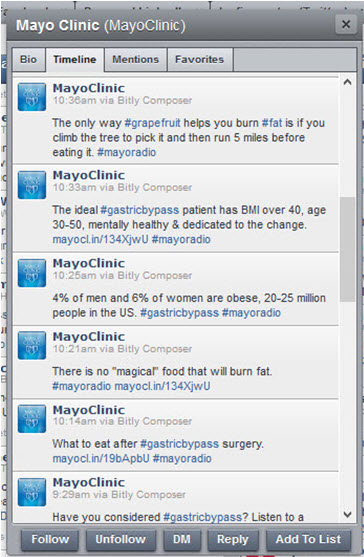You Can't Tweet Like the Mayo Clinic Can Tweet
marydrozario
 In 2013 the Mayo Clinic periodically posted a joke about the grapefruit diet. On the days of the post, they owned "grapefruit" on Twitter. If you looked for "grapefruit" what you got was the Mayo Clinic.
The Mayo Clinic has more than a half million followers on Twitter: they can capture any keyword they want. (Click the post list to get a full-size view.)
In 2013 the Mayo Clinic periodically posted a joke about the grapefruit diet. On the days of the post, they owned "grapefruit" on Twitter. If you looked for "grapefruit" what you got was the Mayo Clinic.
The Mayo Clinic has more than a half million followers on Twitter: they can capture any keyword they want. (Click the post list to get a full-size view.)
Your small private practice can not do that. If you have a few hundred or a few thousand followers, you must select keywords more strategically. When the Mayo Clinic captured "grapefruit" on a lark, they only owned it for about a day. They are big enough to own a different hashtag every day. You need to be influential on your target hashtags for longer than that.
If you are in health care, go to the Healthcare Hashtag Project and look up the key words for your topic. Once you find the hashtags for your topic, see how many tweets a day the topic gets and how many times a day the most influential people tweet. You have to use the hashtag for your core competency in posts, but if it is a highly used hashtag look for another hashtag where you can have a larger influence.
If you aren't in healthcare and no one is keeping a website of hashtag metrics for your industry, just start looking up words that make sense. Those words will connect you to established hashtags. Also look in Hashtagify.me, a tool that helps you find related hashtags.
Another technique is to create your own hashtag. Interestingly, #grapefruitdiet wasn't used on Twitter at that time- if it had been, Mayo couldn't have stolen it from the existing audience without a backlash. However, Mayo could have chosen to create the hashtag at that time and continued to cultivate it as a sales channel.
Remember that if a lot of companies are already targeting the most obvious hashtag, it might not give you the best results. Include less crowded hashtags where you can have a larger impact on the conversation.
-
Originally posted by Mary K.D. D’Rozario on the CRP Blog.